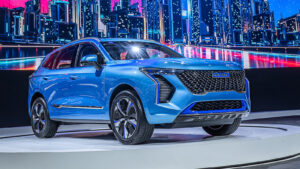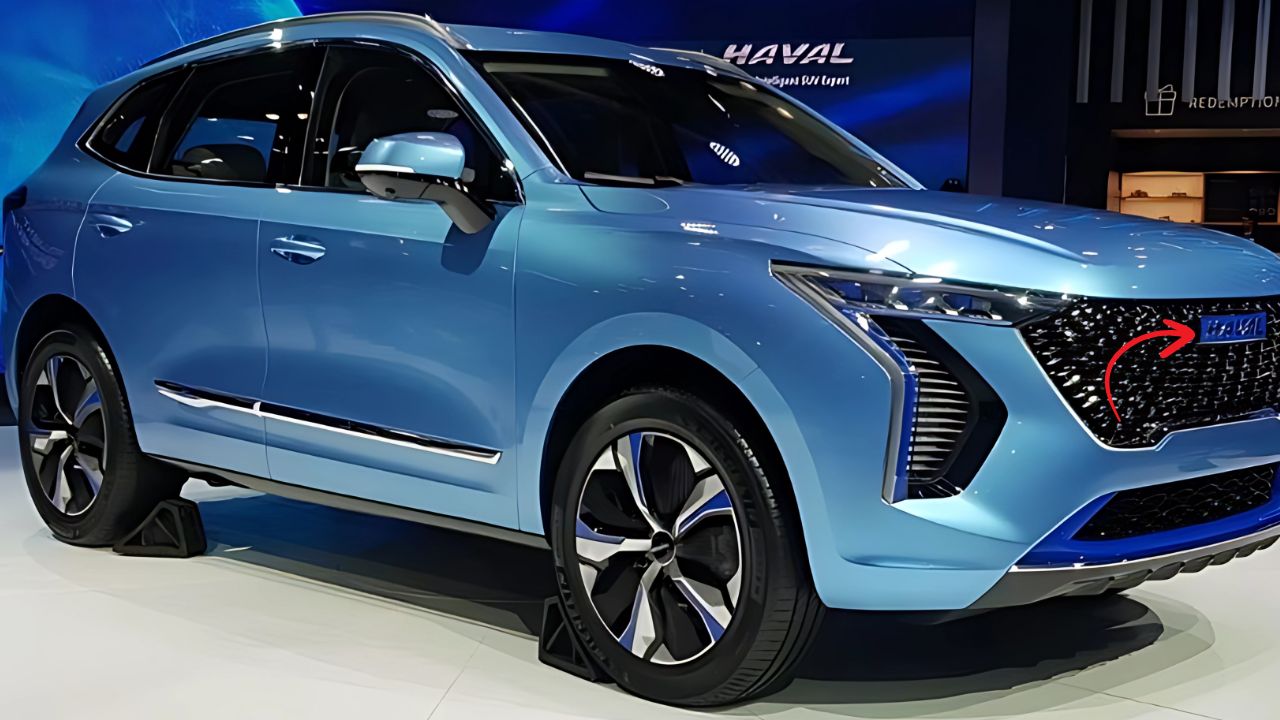The Australian automotive landscape is about to witness another significant shift as the updated 2025 GWM Haval H6 prepares for its imminent launch. This refreshed mid-size SUV represents a bold challenge to the segment-leading Toyota RAV4, promising enhanced power, sophisticated technology, and compelling value that could reshape buyer preferences in one of Australia’s most competitive vehicle categories.
A Strategic Launch Timing
Previously reported to be coming here in 2024, the facelifted Haval H6 rollout is set to start later this month. This timing couldn’t be more strategic, as Australian consumers continue to face extended waiting periods for popular alternatives like the Toyota RAV4 Hybrid, with some dealerships quoting delivery times extending beyond 12 months.
The 2025 Haval H6 arrives as GWM‘s most comprehensive update to their bestselling model, building upon the solid foundation established by the third-generation platform that debuted in 2020. The current, third-generation Haval H6 debuted in 2020, and arrived in Australia in 2021 to replace the 2015-vintage model known in China as the H6 Coupe.
Enhanced Power and Performance Portfolio
The most significant advancement in the 2025 model year centers around its expanded powertrain options. Only front-wheel drive petrol and hybrid powertrains are listed in the certification documents, though GWM has previously indicated all-wheel drive hybrid versions and a plug-in hybrid powertrain will follow later in the year.
The hybrid system represents a particular area of focus, combining a sophisticated 1.5-liter turbocharged petrol engine with an advanced electric motor configuration. This hybrid powertrain delivers an impressive combined output of 179kW of power and 530Nm of torque, establishing it as one of the more potent offerings in the mid-size SUV segment. The system achieves remarkable fuel efficiency, with real-world consumption figures reportedly reaching as low as 5.2 liters per 100 kilometers under optimal conditions.
For those seeking even more performance, GWM has hinted at the possibility of introducing plug-in hybrid variants later in the model year. It’s unclear, then, which powertrain the Haval H6 PHEV will use in our market – whether it’s the heady 342kW/762Nm 1.5-litre turbo PHEV of the Haval H6 GT PHEV with its sub-5.0-second 0-100km/h time, or something more tame. This potential addition could dramatically alter the performance landscape, offering supercar-level acceleration in a practical family SUV package.
Revolutionary Interior Technology
The 2025 model year brings substantial upgrades to the H6’s cabin technology and design philosophy. Inside, there’s a new centre console design and steering wheel, while the carryover 10.25-inch digital instrument cluster now sits next to a larger 14.6-inch infotainment touchscreen.
This technology integration represents a significant advancement over the previous generation, creating a more premium and user-friendly environment. The upgraded infotainment system promises enhanced connectivity options, improved processing power, and more intuitive user interfaces that align with contemporary consumer expectations.
The interior refinements extend beyond technology to encompass materials and build quality improvements. The updated cabin design incorporates better soft-touch materials, improved ergonomics, and enhanced attention to detail that brings the H6 closer to premium segment standards while maintaining its value proposition.
Challenging the RAV4 Dominance
The Toyota RAV4 has long held the crown as Australia’s best-selling SUV, but the 2025 Haval H6 presents a formidable challenge with several key advantages. Price positioning remains one of the H6’s strongest selling points, with entry-level variants typically priced several thousand dollars below equivalent RAV4 models while offering comparable or superior feature sets.
Performance comparisons reveal interesting dynamics between these rivals. While the RAV4 Hybrid produces a total system output of 163kW, the H6 Hybrid’s 179kW represents a meaningful advantage in real-world driving scenarios. The additional torque output of the H6’s system also provides superior overtaking capability and highway performance, particularly when fully loaded with passengers and cargo.
Fuel efficiency comparisons show both vehicles achieving impressive results, though through different methodologies. The RAV4 Hybrid’s naturally aspirated 2.5-liter engine paired with electric assistance achieves approximately 4.8 liters per 100 kilometers, while the H6 Hybrid’s turbocharged 1.5-liter system achieves around 5.2 liters per 100 kilometers. This difference reflects the different philosophical approaches to hybrid technology, with Toyota prioritizing ultimate efficiency while Haval emphasizes performance alongside economy.
Design Evolution and Aesthetic Appeal
The 2025 Haval H6 receives comprehensive exterior styling updates that sharpen its competitive edge. The refreshed design language incorporates more sophisticated lighting elements, refined proportions, and enhanced aerodynamic efficiency. These changes not only improve the vehicle’s visual appeal but also contribute to better fuel economy and reduced wind noise.
The updated front fascia features more prominent LED daytime running lights and a revised grille design that projects greater sophistication. The rear end has been completely redesigned, moving away from the full-width light bar configuration in favor of more distinctive individual taillight elements that provide better brand recognition and improved nighttime visibility.
Interior space utilization remains a strength, with the H6 offering generous passenger accommodation and cargo capacity. The 600-liter boot space expands to 1,485 liters with rear seats folded, providing excellent practical utility for family adventures and daily errands alike.
Safety and Technology Integration
Safety remains paramount in the 2025 H6’s development, building upon the five-star ANCAP safety rating achieved by previous generations. The updated model incorporates enhanced active safety systems, improved structural integrity, and more sophisticated driver assistance technologies.
The comprehensive safety suite includes autonomous emergency braking, adaptive cruise control, lane-keeping assistance, and rear cross-traffic alert systems. These features work cohesively to provide confidence-inspiring protection for occupants while reducing driver fatigue during longer journeys.
Advanced driver assistance systems continue to evolve, with the 2025 model incorporating more sophisticated radar and camera systems that provide better detection capabilities and more natural intervention characteristics.
Market Positioning and Value Proposition
The 2025 Haval H6 enters the Australian market at a time when consumers are increasingly value-conscious while demanding higher levels of technology and refinement. This positioning allows GWM to capitalize on market gaps left by premium brands whose prices have escalated beyond many family budgets.
The H6’s comprehensive warranty coverage, including seven years of unlimited kilometer protection and eight years of coverage for hybrid battery systems, provides additional peace of mind that strengthens its value proposition against established competitors.
Service and maintenance considerations favor the H6, with service intervals extending to 12 months or 15,000 kilometers, reducing ownership costs and inconvenience compared to more frequent service requirements from some competitors.
Expanding GWM Portfolio Strategy
GWM Australia is adding another mid-size crossover SUV to its ranks in the third quarter of this year with the Haval H7. This shares its platform with the H6 and H6 GT but features a locking rear differential, a “light off-road cruising mode”, and unique styling.
This expansion strategy demonstrates GWM’s commitment to the Australian market and their confidence in the underlying platform architecture. The shared platform approach allows for economies of scale while providing consumers with multiple options to suit different preferences and requirements.

The H7’s introduction will create a more comprehensive model lineup that can compete across multiple price points and capability levels, potentially attracting buyers who might otherwise consider alternatives from established brands.
Future Implications and Market Impact
The arrival of the updated 2025 Haval H6 represents more than just another model refresh; it signals the continuing evolution of Chinese automotive manufacturing capabilities and their growing influence in the Australian market. The combination of advanced technology, competitive pricing, and improved refinement demonstrates how quickly the competitive landscape is changing.
Consumer acceptance of Chinese automotive brands continues to grow as quality perceptions improve and value propositions become increasingly compelling. The H6’s success could pave the way for broader acceptance of GWM and other Chinese manufacturers in mainstream Australian automotive consciousness.
The timing of this launch, coinciding with extended waiting times for popular alternatives and increasing interest in hybrid technology, positions the H6 to capture market share from established players who may be struggling with supply chain constraints or aging product portfolios.
A Genuine RAV4 Alternative
The 2025 GWM Haval H6 emerges as a genuine alternative to the Toyota RAV4, offering competitive performance, advanced technology, and compelling value in a refined package. While the RAV4 maintains advantages in brand recognition and resale value, the H6 counters with superior performance, more advanced technology, and significantly better value for money.
For Australian families seeking a capable, efficient, and well-equipped mid-size SUV without paying premium prices, the updated Haval H6 presents a compelling proposition that deserves serious consideration. Its combination of enhanced power, sophisticated technology, and comprehensive warranty coverage creates a package that could reshape the competitive dynamics in one of Australia’s most important vehicle segments.
As deliveries commence and real-world experiences accumulate, the 2025 Haval H6 may well prove that the era of unchallenged segment leadership is coming to an end, replaced by a more diverse and competitive marketplace that ultimately benefits Australian consumers through better products and more competitive pricing.

